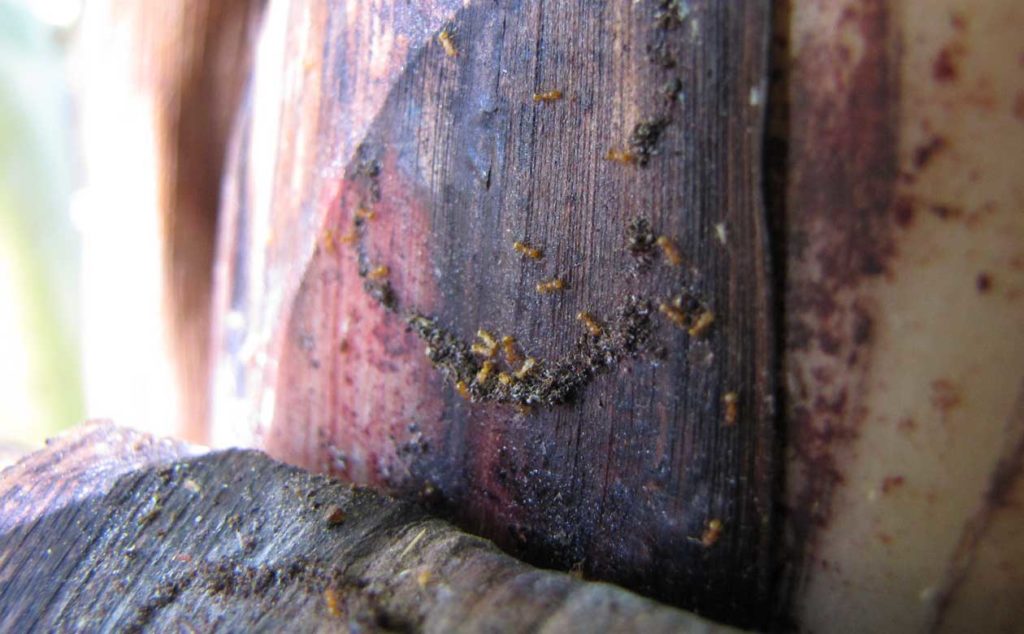When you think of invasive species on Kauai, you might think of feral cats predating on native birds, or Albizia trees growing from the coastline to mountain peaks, competing with native plants for space and resources. While invasive species are a huge problem in our wildlands, they also pose a threat here in our conservation nursery. Every day our team combats invasive garden pests of every kind. From invasive snail and slugs species to pests like ants and aphids that hitched a ride to Hawaii on alien plants and animals and have made a home here in the islands. Here are some of the most common garden pests we fight in the nursery and tips for protecting your home garden from them as well.

Ants are an invasive species often overlooked. There are more than 45 species of ants that have been introduced to Hawaii and pose a threat to our work in the nursery in many ways. Ants reproduce in mass numbers and can cause root disturbance, farm other pest insects like aphids, create nests in hollow branches, twigs, and stems. They can be difficult to spot and are often noticed after damage has already been done. They create nests in potted plants and must be removed before plants can be sent for outplanting.

Rats were introduced to Hawaii when the Polynesian voyagers arrived. They were stowaways on the canoes that quickly reproduced and thrived. After the arrival of Captain Cook in 1778, other species of rats began to make Hawaii their home including the roof rat, Norway rat, and the common house mouse. All rats are omnivores and cause a plethora of issues in the plant conservation field, not just in Hawaii but worldwide. Rats will debark trees, eat native tree snails and slugs as well as native insects. The seeds of many native Hawaiian plants are a delicacy to rats. They eat new vegetative growth on plants in the nursery and treat our seed flats like a buffet. We put wire cages over most seed flats to protect them from these ravenous intruders. Bait stations are also strategically placed throughout the nursery. Both prevention methods not only use up our time, but cost money.

While most non-native species have a negative impact on our environment and our work in conservation, some can have positive effects. One such creature is the common lacewing. Not originally native to Hawaii, this beneficial insect is a treasure here in our nursery. They are members of the Chrysopidae family which includes 85+ genera all of which are predatory. Their alligator-like larvae are often referred to as “aphid lions” and for a good reason. The larvae can eat over 200 pest insects a week, their favorite being aphids, but they will also eat spider mites, caterpillars, etc.
We often find their eggs on the leaves of native Hibiscus plants here in our nursery. Mother lacewings almost always lay eggs on plants that are currently infested with pest insects, so when their babies are born, there is a feast awaiting them. However, this is a cycle we are able to manipulate in the nursery. When we find unhatched lacewings eggs, we can carefully move them to an area with a pest infestation we are currently battling. When the larvae hatch they are insatiable! By encouraging lacewing activity in the nursery we are able to cut back/limit the amount of pesticides we use to treat for pest insects and help create a healthy balance of pests and beneficial insects.
Slugs. You can easily prevent slugs and snails through applying a bait pesticide labeled for home garden use and following the label instructions. However, if you would prefer the pesticide-free route, there are a few old gardener tricks that work well:
Invasive plants. You can combat those pesky weeds with just a few simple tricks and vigilant weed pulling:
General Pests. A garden can be a sanctuary for us, but it can also look like a gourmet buffet to some pest. If multiple plants of one species are planted close together, this can create a “hot spot” for pests, kind of like a billboard saying “Hey, you like peppers, well there’s tons here!”